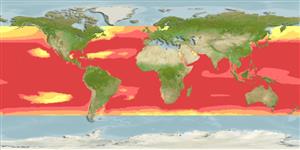Environment: milieu / climate zone / depth range / distribution range
ນິເວດວິທະຍາ
ສັດທະເລ; ນ້ຳກ່ອຍ; ປາທີ່ມີການເຄື່ອນຍ້າຍໃນສະເພາະມາະຫາສະມຸດ (Ref. 51243); ລະດັບຄວາມເລິກ 1 - 1602 m, usually 1 - 250 m (Ref. 6390). Tropical; 15°C - 31°C (Ref. 168); 50°N - 50°S, 180°W - 180°E
Worldwide in tropical and subtropical seas, but absent from the Mediterranean Sea. Highly migratory species.
Length at first maturity / ຂະໜາດ / ນ້ຳໜັກ / Age
Maturity: Lm 103.3, range 78 - 158 cm
Max length : 239 cm FL ຕົວຜູ້/ບໍ່ມີເພດ; (Ref. 40637); common length : 150 cm FL ຕົວຜູ້/ບໍ່ມີເພດ; (Ref. 168); ນ້ຳໜັກສູງສຸດທີ່ເຄຍຈັດພີມມາ: 200.0 kg (Ref. 26550); ອາຍຸສູງສຸດທີ່ເຄຍລາຍງານມາ: 9 ປີ (Ref. 72462)
ຄີ (ໜາມ)ແຂງຢູ່ຫຼັງປາ (ທັງໝົດ) : 11 - 14; ຄີຫຼັງຂອງປາ (ຄີອ່ອນ) (ທັງໝົດ) : 12 - 16; ຄີ(ໜາມ) ແຂງຢູ່ຄີກົ້ນປາ
ກຸ່ມປາກະດູກແຂງ
ຄວາມຖີ່ຂອງກຸ່ມຖ່າຍທອດພັນ
ປາທີ່ມີການເຄື່ອນຍ້າຍຈາກທະເລໄປຫານ້ຳຈືດ ແລະນ້ຳຈືດຫາທະເລ
ປາທີ່ມີການເຄື່ອນຍ້າຍຈາກທະເລແລະໄປໄຂ່ຢູ່ນ້ຳຈືດ
ຄີກົ້ນຂອງປາ
ສັດທີ່ມີກະດູກສັນຫັຼງ
ການຖ່າຍທອດທາງກຳມະພັນຈາກພໍ່ແມ່ຫາລູກ: 0; ຄີກົ້ນຂອງປາ: 11 - 16; ສັດທີ່ມີກະດູກສັນຫຼັງ: 39. This large species is distinguished by the following characters: elongate, fusiform body, slightly compressed laterally; total gill rakers on first gill arch 26-34; dorsal fins 2 and separated only by a narrow interspace, the second followed by 8-10 finlets; anal fin followed by 7 to 10 finlets; large specimens may have very long second dorsal and anal fins, becoming well over 20% of fork length; pectoral fins moderately long, usually reaching beyond second dorsal-fin origin but not beyond end of its base, usually 22-31% of FL; 2 flaps (interpelvic process) between pelvic fins; body with very small scales; corselet of larger scales developed but not very distinct; caudal peduncle very slender, bearing on each side a strong lateral keel between 2 smaller keels; no striations on ventral surface of liver; swimbladder present. Colour of back metallic dark blue changing through yellow to silver on belly; belly frequently crossed by about 20 broken, nearly vertical lines; dorsal and anal fins, and dorsal and anal finlets bright yellow, the finlets with a narrow black border (Ref. 9684).
An oceanic species occurring above and below the thermoclines. Pelagic in open water , but rarely seen near reefs (Ref. 48637). They school primarily by size, either in monospecific or multi-species groups. Larger fish frequently school with porpoises, also associated with floating debris and other objects. Feed on fishes, crustaceans and squids. It is sensitive to low concentrations of oxygen and therefore is not usually caught below 250 m in the tropics (Ref. 28952, 30329). Peak spawning occurs during the summer, in batches (Ref. 9684, 51846). Eggs and larvae are pelagic (Ref. 6769). Encircling nets are employed to catch schools near the surface (Ref. 9340). Caught mainly with longlines and purse seines. Marketed mainly fresh, frozen, canned (Ref. 9684), but also smoked (Ref. 9987). Highly valued for sashimi (Ref. 26938).
Spawn throughout the tropical and equatorial waters of the major oceans (Ref. 6390). At higher latitudes, spawning is seasonal, with peaks in summer; may continue throughout the year at lower latitudes (Ref. 6390).
Yellowfin tuna are multiple spawners, ie they spawn every few days over the spawning period (Ref. 6390). Eggs and sperm are released into the water for fertilisation (Ref. 6390).
Collette, B.B. and C.E. Nauen, 1983. FAO Species Catalogue. Vol. 2. Scombrids of the world. An annotated and illustrated catalogue of tunas, mackerels, bonitos and related species known to date. Rome: FAO. FAO Fish. Synop. 125(2):137 p. (Ref. 168)
IUCN Red List Status (Ref. 130435)
Threat to humans
Harmless
Human uses
ການປະມົງ: ທີ່ມີການຄ້າສູງ; ການລ້ຽງສັດນ້ຳ: ການທົດລອງ; ຊະນິດປາທີ່ຖືກນຳໃຊ້ເຂົ້າໃນການຫາເພື່ອເປັນເກມກິລາ: ແມ່ນ
ເຄື່ອງມື
Special reports
Download XML
ແຫຼ່ງອີນເຕີເນັດ
Estimates based on models
Preferred temperature (Ref.
123201): 16.5 - 28.9, mean 26.7 °C (based on 6382 cells).
Phylogenetic diversity index (Ref.
82804): PD
50 = 0.5039 [Uniqueness, from 0.5 = low to 2.0 = high].
Bayesian length-weight: a=0.01479 (0.01210 - 0.01808), b=3.03 (2.99 - 3.07), in cm total length, based on LWR estimates for this species (Ref.
93245).
ຊັ້ນເຂດຮ້ອນ (Ref.
69278): 4.4 ±0.4 se; based on diet studies.
Generation time: 2.8 (2.3 - 3.5) years. Estimated as median ln(3)/K based on 46
growth studies.
ຄວາມຢືດຢຸ່ນ (Ref.
120179): ຂະໜາດກາງ, ປະຊາກອນຕຳ່ສຸດທີ່ໃຊ້ເວລາສອງເທົ່າ 1.4 - 4.4 ປີ (K=0.13-0.42; tm=2-5; tmax=8; Fec=200,000).
Prior r = 0.36, 95% CL = 0.24 - 0.54, Based on 9 full stock assessments.
Fishing Vulnerability (Ref.
59153): Moderate to high vulnerability (46 of 100).
Climate Vulnerability (Ref.
125649): Moderate vulnerability (42 of 100).
Nutrients (Ref.
124155): Calcium = 41 [22, 86] mg/100g; Iron = 2.84 [1.17, 6.68] mg/100g; Protein = 23.7 [22.2, 25.1] %; Omega3 = 0.274 [0.166, 0.457] g/100g; Selenium = 82.4 [21.0, 256.4] μg/100g; VitaminA = 29.6 [3.7, 227.6] μg/100g; Zinc = 0.524 [0.292, 0.972] mg/100g (wet weight); based on
nutrient studies.
